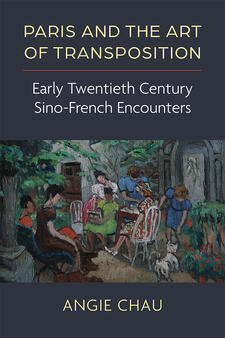The Value of Art and Travel in Uncertain Times

This guest author post is by Angie Chau, author of the new book Paris and the Art of Transposition: Early Twentieth Century Sino-French Encounters. The book is now available in hardcover, paperback, and open access.
Leading up to Xi Jinping’s visit with the U.S. President Biden in November, a New York Times op-ed described an underlying sense of pessimism at a Council on Foreign Relations meeting held in New York: “At the very time when understanding China has become more important than ever, they were losing visibility, access and insight, thanks to increasing repression in China and new restrictions enacted by the United States. There was nothing to be done. It was out of their hands. A melancholy camaraderie filled the room. It felt like the end of an era” (Farah Stockman, “Farewell to the U.S.-China Golden Age,” NYT, Nov. 14, 2023). By now, the increasingly tense relationship between China and the rest of the world has extended beyond the diplomatic and financial sectors to the academic sphere, and as the recent Luce/ACLS Program in China Studies Report highlights, a shared reluctance to collaborate with scholars in China or even travel to China has been one of the main repercussions of this chilling effect (“China Studies in an Uncertain Age,” October 2023, 12).
While the outbreak of the covid pandemic in 2019 certainly played a significant role in decreasing the possibility of intercultural exchanges between China and North America (mostly by making travel restrictions and visa applications extremely difficult to navigate if not completely impossible for a few years), the number of Chinese international students studying overseas in North America and inversely, those from North America studying in China, have not rebounded since.
In the art documentary The Price of Everything (dir. Nathaniel Kahn, 2018), art collector Stefan Edlis observes, “There are a lot of people who know the price of everything and the value of nothing.” My new book Paris and the Art of Transposition: Early Twentieth Century Sino-French Encounters picks up on this question of the seemingly mysterious, indeterminate value of art: how should we think about the value of art, beyond the criteria buttressed by the pillars of commercial and academic institutions that respectively determine its market price in the auction house on the one hand, and its place in national art historiographies on the other? Paris and the Art of Transposition makes a compelling case for the importance of intercultural exchange and artistic expression, precisely in uncertain geopolitical times such as the present moment.
As my book suggests, one way of assessing the value of art is to be attentive to the role of modern Chinese artistic collaborations and interactions, too many of which have previously been skipped over by national histories.
Art and travel can be aspirational. Attending a Picasso exhibit in 1945, the painter Chang Yu 常玉, whose work I discuss in Chapter 2, imagined a future inspired by Picasso’s surrealist depictions of the human body: “Deformation in Picasso’s painting is only the first step… We will be able to live in the air or underwater… We will go to Asia like we go to Versailles, we will spend a weekend on the moon” (p. 55). Chang Yu imagined that one day tourists would flock to Asia in the same way that cosmopolitan travelers visited world-renowned Parisian landmarks like Versailles.
The process of viewing unfamiliar art can also be self-reflexive and transformative. Chapter 3 of my book analyzes the art criticism of the translator Fu Lei 傅雷, who recounted that his time in France led him to appreciate the beauty of Chinese culture: “I first fell in love with Chinese art when I was twenty-one or twenty-two, studying Western painting at the Louvre in Paris” (p. 70). Fu Lei’s recollections of time spent at the Louvre as a young Chinese art student shows that we can learn about ourselves and where we come from through the contrast of being away from home. While today many people may feel more comfortable taking online courses or communicating on social media instead of in real life interactions, these modes of virtual engagement are not interchangeable with the experience of being in a new place.
Sometimes, the impact of travel may not be immediately discernible or quantifiable; it may not be expressible or legible to others, and even for the individual, its significance may be difficult to pinpoint. Chapter 1 of my book includes a memorable passage from the poet Xu Zhimo’s Fragments of Paris, which was published in 1927, about his time in Paris, “Most of the time, I only watched the excitement from the banks of the Seine, but I can’t really say that I never went into the water either—even in those cases, I stayed in the shallows, never daring to go deeper. This thin whorl of influence and the force of having swam far outweighed anything I would have gained from standing far away onshore” (p. 13). According to Xu Zhimo, even the firsthand experience of watching from the sidelines could be uniquely beneficial compared to not taking the risk to venture out at all.
Xu Zhimo’s ambivalent attitude reaffirms the romantic if somewhat ambivalent image of everyday life for Chinese travelers in 1920s Paris in accounts commemorated in Chinese and French cultural histories, an image that also persists in popular media. My book’s conclusion includes a brief reflection of my surprise upon discovering Chang Yu’s art in the Taiwanese pop star Jay Chou’s 周杰倫 music video for his 2022 single, “Greatest Works of Art.” In the video, which takes place in the La Samaritaine department store, Chou and his friends, including the celebrity pianist Lang Lang, travel back in time to 1920s Paris to hang out with bohemian artists like Salvador Dalí and René Magritte. Near the song’s conclusion, Chou raps, “Fragments of Paris, the grammar of sadness, we use music to read this/ In the evening light, I exchanged the traveler’s tea for coffee/ After that, he fell in love with ‘bitterness,’ this complex word” (p. 165).
The painter Pan Yuliang 潘玉良, who ended up staying in Paris for the rest of her life after relocating there permanently in 1937, wasn’t scared to question the value of her overseas experiences and avoided using it as proof of artistic success: “Internationally and domestically, I’ve had four solo shows and participated in more than twenty group exhibits; this is the summary of my artistic life. Now over forty [years old], with not much to my name, I must ask myself what little I have accomplished. I often say, time has neither past nor present, people are neither great nor weak, without art there is no life, which is to say, all of life is for art, and art is for life” (p. 140).
Even in instances where travel and studying art in Paris did not guarantee an individual’s happy professional outcome, such as in Pan Yuliang’s case in Chapter 6, the stories about the Chinese writers and artists featured in Paris and the Art of Transposition serve as a timely reminder that humans can learn from feeling awkward in the face of strange encounters, and when we are challenged to confront unexpected sights and ideas in a different place.
Nearly an entire century later, the 1920s–1940s interwar period may feel like a distant past for the contemporary reader, but Paris and the Art of Transposition highlights useful parallels with the tense geopolitical relations between China and North America today. In the aftermath of the pandemic, as students have become more and more accustomed to studying online and scholars recognize that the space for international collaborations is narrowing (“Doing Fieldwork in China and Beyond the Covid–19 Pandemic: A Study,” Made in China, 2023), these earlier instances of artistic collaboration and travel serve as a powerful reminder of the distinctive experience of being in a new place, and the potential for intercultural dialogue even in the most challenging of times.



